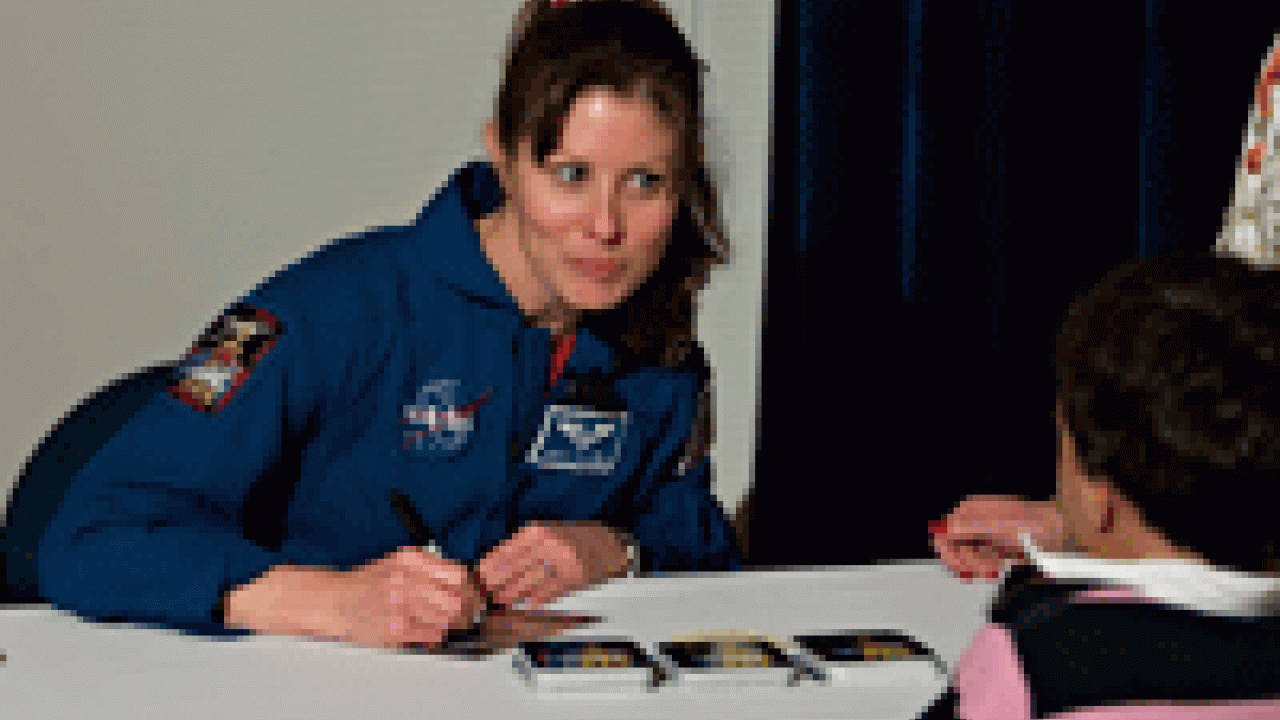What sort of a person does it take to be an astronaut?
Well, Tracy Caldwell spent nearly 13 days up in a space shuttle — cramped quarters, minimal sleep and freeze-dried food — and still wished it could have been longer. Caldwell, who spoke on Jan. 25 to a crowded Freeborn Hall, typified the unique brand of employee that NASA prides itself on having as part of its banner staff.
"I would spend almost all of my free moments looking out the window at the Earth," Caldwell said of her time aboard the Space Shuttle Endeavour. "I felt so privileged to be one of the few people to be able to see the living Earth."
A UC Davis alumna who received her doctorate in chemistry in 1997, Caldwell was one of seven members of STS-118, a mission last August that traveled to the International Space Station. Caldwell's presentation was part of the College of Letters and Science's Dean's Speaker Series. The talk was co-sponsored by the Cal Aggie Alumni Association.
Joining her on stage was Chancellor Larry Vanderhoef, who read off an exhaustive list of Caldwell's accomplishments — including her fluency in Russian and sign language, and her time as an electrician for her father. Also participating in the introduction was UC Davis Professor Don Land, who was Caldwell's Ph.D. adviser and one of the few guests she invited to the Kennedy Space Center in Florida for the Aug. 8 launch.
"I'll never forget the opening line she wrote on her application: 'I have always wanted to be an astronaut,'" Land recalled fondly. "It seemed that with almost everything she did, it was as if she was checking off a list of what some needed to have in order to be a perfect NASA candidate."
All of Caldwell's work and determination paid off. NASA selected her on her first attempt in 1998 to be part of the astronaut program. She spent several years training in NASA's Houston headquarters, working as a software developer and mission control communicator. Finally, with STS-118, her moment came to be aboard a space-bound flight, but there was no real time to bask in the honor of her selection — the training began immediately.
"There's really no typical day for an astronaut." Caldwell said. "One day you'll be trying out equipment, another you'll be in a classroom, another you'll be underwater performing mock missions."
Most of Caldwell's talk last week focused on the mission itself, as she showed slides and videos that recounted her experiences from a few days before launch through to the shuttle's successful touchdown back in Florida on Aug. 21. Of the pictures, she prided herself on the shuttle's linkup with the space station — it performed an upside down maneuver to give a better view — and a shot she took herself of a drop of honey that hung suspended in the cabin.
The mission was primarily a repair and construction job on the International Space Station. Among other objectives, the Endeavour crew had to deliver a new segment to the station's backbone and repair one of the malfunctioning gyroscopes — an instrument that stabilizes the orbiting science lab.
The mission made some unexpected headlines when one of the planned spacewalks (or extra vehicular activity) had to be terminated when it was discovered that the specialist performing the maneuver, Rick Mastracchio, had a tear in his glove. Caldwell herself was safe back inside the space station — she's the "quarterback" of these missions, directing from afar — and, ultimately, Mastracchio's scare was short and precautionary.
"You spend so much time training for every possible scenario," said Caldwell, who deeply praised NASA's safety record. "Every part is inspected and certified by an engineering team whose sole job is to make that one part as perfect and infallible as humanly possible."
Not everything was serious, focused work for the crew of Endeavor. Caldwell celebrated her 38th birthday while in orbit, and showed a video of the crew's impromptu party: mission Commander Scott Kelly put a lighter in a brownie and floated it in her direction while they all sang "Happy Birthday." Then, of course, there is the effect of weightlessness on long hair. Caldwell joked that her mane acted like a filter for anything that floated through the cabin.
Detaching from the space station and heading back home was a teary experience for all the astronauts. Some of them stay behind to continue their work while others are ferried back to the Earth for the first time in months. But as Caldwell pointed out, the work never ends for any of the astronauts, and landing back on Earth, which is "basically a controlled crash," is as difficult as anything else the weary crew had to perform.
At the end of her talk, Caldwell gave a gift to Land and Vanderhoef: a UC Davis banner encased in plastic with a document from NASA certifying that it had been taken into orbit.
During a question-and-answer session afterward, a young girl — one of the many children that attended the talk — asked Caldwell when she was going back into space. Caldwell explained the process of post-mission debriefing that all astronauts go through, and the years it takes for a reapplication to go through, but finished with, "Good question. I'd like to know when I'm going back myself."
Tom Dotan is a News Service intern.
Media Resources
Clifton B. Parker, Dateline, (530) 752-1932, cparker@ucdavis.edu
